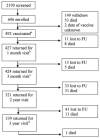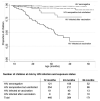Survival from 9 months of age among HIV-infected and uninfected Zambian children prior to the availability of antiretroviral therapy
- PMID: 18680417
- PMCID: PMC2753245
- DOI: 10.1086/591203
Survival from 9 months of age among HIV-infected and uninfected Zambian children prior to the availability of antiretroviral therapy
Abstract
Background: Few prospective studies have measured survival rates among human immunodeficiency virus (HIV)-infected children in sub-Saharan Africa prior to the availability of antiretroviral therapy.
Methods: In the context of an observational study of the immunogenicity of measles vaccine in Zambia, we prospectively followed up children from approximately 9 months of age and assessed survival rates, risk factors for mortality, and circumstances at the time of death according to HIV-infection or HIV-exposure status.
Results: There were 56 deaths among 492 study children during follow-up to 3 years of age. Thirty-nine percent of the 105 children with HIV infection died during the study period, compared with 5.0% of the 260 HIV-seropositive but uninfected children and 1.6% of the 127 HIV-seronegative children. Estimated survival probabilities from 9 through 36 months of age were 52% among HIV-infected children, 95% among initially HIV-seropositive but uninfected children, and 98% among HIV-seronegative children. In multivariable analyses, history of a clinic visit within the 4 weeks prior to study entry (adjusted hazard ratio, 4.6; 95% confidence interval, 1.5-13.5), hemoglobin level <8 g/dL at study entry (adjusted hazard ratio, 4.4; 95% confidence interval, 1.5-12.6), and CD4(+) T lymphocyte percentage <15% at study entry (adjusted hazard ratio, 3.2; 95% confidence interval, 1.1-9.5) were associated with mortality among HIV-infected children.
Conclusions: Only approximately one-half of HIV-infected Zambian children who were alive at 9 months of age survived to 3 years of age, supporting the urgent need for the prevention of mother-to-child transmission of HIV and the early diagnosis and treatment of HIV infection in children in sub-Saharan Africa.
Figures



References
-
- UNAIDS. World Health Organization . World Health Organization; Geneva: 2007. AIDS epidemic update: December 2007. (Report no.: UNAIDS/07.27E/JC1322E).
-
- Newell ML, Coovadia gH, Cortina-Borja M, et al. Mortality of infected and uninfected infants born to HIV-infected mothers in Africa: a pooled analysis. Lancet. 2004;364:1236–43. - PubMed
-
- Bolton-Moore C, Mubiana-Mbewe M, Cantrell RA, et al. Clinical outcomes and CD4 cell response in children receiving antiretroviral therapy at primary health care facilities in Zambia. JAMA. 2007;298:1888–99. - PubMed
-
- Little K, Thorne C, Luo C, et al. Disease progression in children with vertically-acquired HIV infection in sub-Saharan Africa: reviewing the need for HIV treatment. Curr HIV Res. 2007;5:139–53. - PubMed
Publication types
MeSH terms
Grants and funding
LinkOut - more resources
Full Text Sources
Medical
Research Materials

